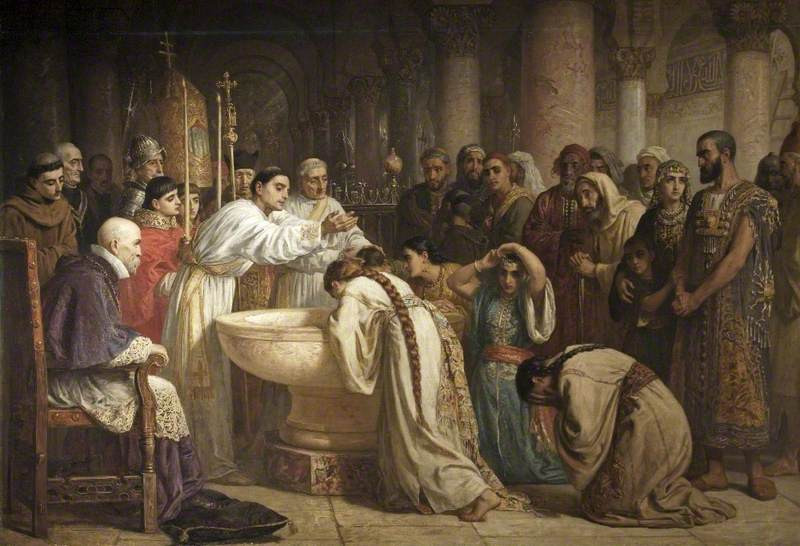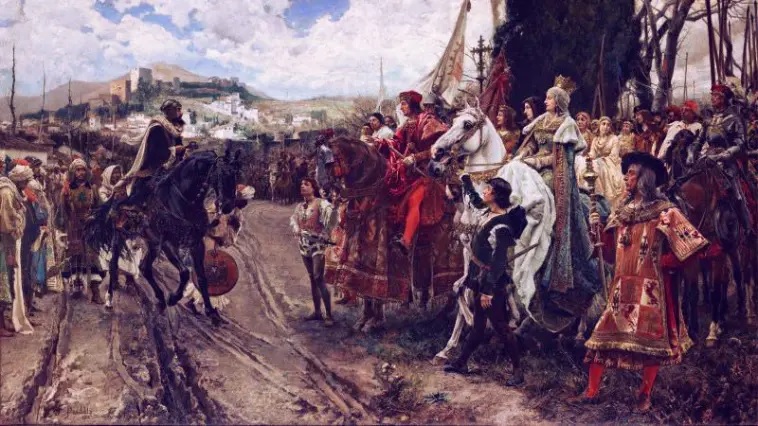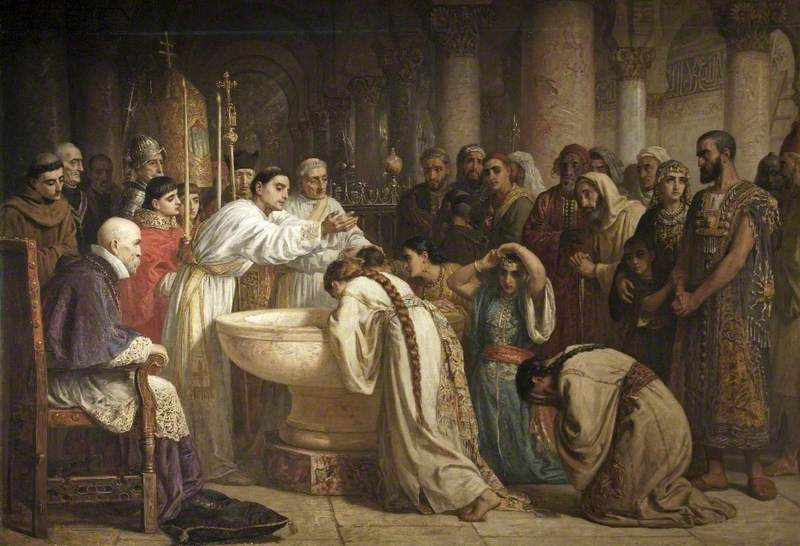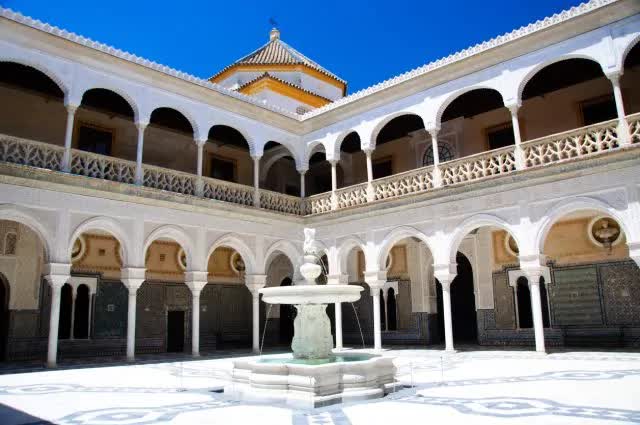
HOW WERE EUROPEAN MUSLIMS ERADICATED?
Muslims conquered Spain in 711. During the approximately eight centuries that followed, Spain experienced a golden age of science, culture, and trade. With the withdrawal of the Umayyads from the political scene, Muslims became fragmented, leading to the emergence of small emirates that fought among themselves. From 1085 onwards, the Spanish began to slowly move southward from the north.
Muslims gradually fell under the dominance of the kingdoms of Leon, Aragon, Castile, and Navarre. The Spanish, fearing the Muslim sultanate in the south, granted them freedom. These Muslims were called Mudajjan (permitted to remain) in Arabic and the Spanish call them Mudéjar. This is now a term for a style of art.
In the 14th century, they attempted a rebellion but, failing, many had to flee south. The Mudéjar, living in ghettos, numbered about 500,000 in 1492, making up 30% of the population.
Reconquest
In 1492, with the fall of the last Muslim state centered in Granada, the Spanish and Portuguese fully controlled Iberia. This period is known as the Reconquista. Muslims were granted freedom, and all were considered Mudéjar. Jews, however, were expelled, with 200,000 Jews leaving the country. Some Jews survived by pretending to be Christians, but this group, referred to as Marranos (swines) by the Spanish, did not last long due to the pressures of the Inquisition. Missionary activities also began among Muslims.
A few years later, the Portuguese and Spanish changed their minds. In 1497 in Portugal and in 1502 in Spain, Muslims were given the choice of exile, baptism, or death. Some governors delayed this order, fearing economic collapse. The uprisings initiated by the Mudéjar in some places were suppressed.
Mudéjar sought help from the Mamluk and Ottoman sultans. Both were unwilling to risk war with the Spanish at the time but attempted to threaten them with actions involving Christians in their own lands. Ottoman Sultan Bayezid II appealed to the Pope and sent Kemal Reis to the Spanish coast. These ships transported 200,000 Muslims to North Africa.
200,000 Muslims resisted and were killed. 50,000 Muslims were baptized, hoping the pressure was temporary. These converts were known as Moriscos (Moorish).

Oran Fatwa
In places with tolerant governors, Muslims who did not accept baptism were not killed but enslaved. Moriscos were not allowed to live in ghettos. The Inquisition strictly monitored the sincerity of converts, checking for signs like circumcision, pork consumption, and performing ablution.
In 1501, a scholar from Oran stated that these Muslims must emigrate immediately. But in 1504, another Oran scholar, Ahmad ibn Abi Jum'ah al-Maghrawi, issued a farsighted fatwa allowing Muslims to appear Christian outwardly while secretly maintaining their faith, performing prayers with their eyes, giving zakat as charity, and even committing forbidden acts out of necessity, including making the sign of the cross. This became known as the Oran Fatwa.
As the government relaxed its restrictions, the situation for the Moriscos improved, and some openly practiced Islam, particularly in places like Valencia. However, the Portuguese and Spanish did not trust the Moriscos. They feared an invasion by the Ottomans, who now dominated the Mediterranean, using this pretext. In 1575, the Ottomans, allied with France, considered invading Spain to rescue them. The Spanish confiscated weapons from the Moriscos.
Ottoman Sultan Selim II aimed to capture Malta and use it as a base to launch an invasion of Spain. In 1576, he planned to send a three-pronged fleet to land between Murcia and Valencia, with the French attacking from the north and the Moriscos rising in revolt. Meanwhile, 4,000 Turkish and Berber volunteers had landed in Iberia. However, it did not succeed. Preoccupied with the conquest of Cyprus, the Sultan, through the Governor of Algiers Kılıç Ali Pasha, sent weapons, soldiers, and supplies to the Moriscos.

Death to the Moriscos
From 1567 onwards, the pressure on the Moriscos increased, with bans on speaking Arabic and dressing like Arabs. Although they revolted, they achieved nothing. Between 1609-1614, the government began systematically expelling them. The last of the Granada Moriscos were expelled in 1727, given three days to leave the country without their belongings. About 20% managed to hide, and another 20% secretly returned. In 1628, King Philip IV ordered that this matter be dropped, allowing the Moriscos to breathe easier.
The Moriscos who migrated to North Africa openly practiced their Islam. This community, different in type and culture, is called Moors in Morocco and Mauritania. Some Moriscos also moved to Marseille, and through Sicily, they migrated to cities like Thessaloniki, Belgrade, Istanbul, Adana, Damascus, and Tripoli. The government granted them tax exemptions and recruited those with maritime skills into the navy. Ottoman Sultan Ahmed I wrote letters and sent gifts to the rulers of England and France, requesting good treatment for the Moriscos in their countries.
Children from marriages between Moriscos and Portuguese or Spaniards could stay in Iberia. These descendants, and those who returned to Iberia, still know their past and distinguish themselves from other Christians. Since 2006, the issue of granting citizenship back to the Moors has been discussed in Spain.
The Morisco of Don Quixote
The Spanish geographer, writer, and diplomat Leo Africanus (1494–1554) was a Moor kidnapped and baptized by Spanish pirates. Estevanico (1500-1539), one of the first explorers of America, was also of this background. Pushkin’s novel, *The Moor of Peter the Great*, tells the story of the Tsar’s Moorish godson and aide. Shakespeare’s Othello is a Moorish officer in the Venetian army, depicted as exotic, sensual, and untrustworthy, and always portrayed as black.
Cervantes, who was not fond of Muslims, features a Morisco in Don Quixote. He describes him as wise but demonic, valuing money more than religion. This exile and forced baptism inflicted deep wounds on the social, cultural, and economic life of both Muslims and Spaniards. Muslims were wealthy and intellectual, holding the arts, agriculture, and craftsmanship. It would take a long time for the Spaniards to fill this gap.

Is it only Iberia?
In Sicily, conquered in 827, Muslims were the majority at the beginning of the 11th century. The Normans, who invaded the island in 1090, granted Muslims freedom. Even in this period, mosques were found at every step in Palermo, and Arabic was the official language. Even the kings used Sharia principles when preparing laws.
Muslims who revolted to reclaim control were exiled to the cities of Lucera and Bari in Italy in 1223. After 1290, they were forced to choose between exile, baptism, and death. Like Andalusia, all traces of Muslims were erased in Sicily. Memories of that era survive, albeit sparsely, in architectural works.
When the Russians annexed the khanates of Kazan, Kasim, and Astrakhan, those who could escape took refuge in the Ottoman Empire. Those who could not escape were either massacred or baptized. Many famous Russians, like Turgenev, Rachmaninoff, and Prince Yusupov, are descended from Tatar beys. Putin's statement, "Scratch a Russian, and you'll find a Tatar," illustrates this. Estonian Tatars met the same fate.
Europeans did not allow the Ottoman captives to practice their religion. The Muslims left in the Balkans after the Ottoman withdrawal also faced assimilation. Thus, through a comprehensive and flawless ethnic cleansing, the European continent was cleared of Muslims.
The history of Christians seeing Jews as absolute enemies is marked by famous pogroms and massacres throughout Europe. The fear of people of different colors in colonized countries, not even considering them as human, is a well-known fact.
However, during that period, non-Muslims in the Islamic world could freely live their cultures and maintain their identities. This is not surprising, as Christians did not tolerate even those of different sects among their own religion in the Middle Ages and even the Modern Age. In Europe, the culture of “living together” and the idea of “tolerance towards the other” did not develop. Nation-states inherited this culture. Although the catastrophe of the World Wars brought Europeans to their senses, it was too late.
Önceki Yazılar
-
THE FIRST UNIVERSITY IN THE WORLD WAS FOUNDED BY MUSLIMS3.12.2025
-
WHO BETRAYED PROPHET ISA (JESUS)?26.11.2025
-
IT HAS BEEN MORE THAN 100 YEARS SINCE ITS ABOLITION, BUT... IS THE CALIPHATE BEING REESTABLISHED?19.11.2025
-
GREETINGS TO YOU, O OTTOMAN SANJAK!…12.11.2025
-
ROTHSCHILDS BROUGHT THE END OF THE OTTOMAN EMPIRE!5.11.2025
-
SHEIKH BEDREDDIN, SON OF THE QADI OF SIMAVNA29.10.2025
-
THE ROOTS OF THE ENGLISH POLITICIAN IN TURKEY – THE TRAGIC END OF ALI KEMAL BEY22.10.2025
-
WHERE IS THE RED APPLE?15.10.2025
-
THE ABBASIDS IN ANATOLIA1.10.2025
-
IMAMS AND MUFTIS AS OFFICERS IN THE OTTOMAN ARMY24.09.2025